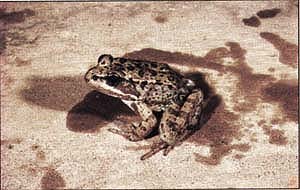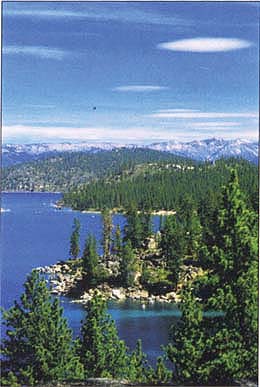All Issues
Science briefs
Publication Information
California Agriculture 55(3):5-6.
Published May 01, 2001
PDF | Citation | Permissions
Full text
Pesticides linked to frog decline
Researchers have found a significant correlation between agricultural pesticide drift and the decline of the California red-legged frog.
Once abundant from Point Reyes to the Sierra Nevada and Redding to Baha, the California red-legged frog has been extirpated from more than 70% of its historic range, and many of the remaining populations have declined precipitously.
“If it turns out that pesticides are the cause, we'll have to do more than set aside habitats if we are to protect the species,” says Carlos Davidson, California State University-Sacramento environmental studies professor. “We'll have to do something about the amounts of pesticides that are used and how they are applied.”
The study, published in Ecological Applications (April 2001), encompassed almost all of California. Davidson (a UC Davis Ph.D.), UC Davis population biology professor H. Bradley Shaffer and Mark R. Jennings of the California Academy of Sciences, mapped the disappearance of red-legged frog populations using museum records dating back to the mid-1800s.
Of 237 identified sites that once had frog populations, the authors found that 48% no longer do. Using a geographic information system (GIS) approach, they compared the patterns of decline with various hypotheses, including global climate change, increased ultraviolet radiation, pesticides and habitat destruction. Other theories for the frog's decline, such as disease and introduced exotic fish or bullfrogs, did not lend themselves to this analysis and therefore could not be tested.
The California red-legged frog has been extirpated from 70% of its historic range. Windborne agricultural pesticides may be an important contributing factor.
The percentage of upwind land use in agriculture for sites where the red-legged frog had disappeared was 6.5 times greater than for sites where the frogs still exist, suggesting that windborne agrochemicals may be an important factor.
“The impact of pesticides on aquatic ecosystems in California almost certainly goes far beyond red-legged frogs,” Shaffer says. “Amphibians, by virtue of their aquatic habits and permeable skin, may be one of the first groups to show the effects. As such, they may well be a harbinger of things to come for other species if we continue applying pesticides at current levels.”
The U.S. Fish and Wildlife Service placed the frog on its threatened list in 1996. In March 2001, the agency designated 4.1 million acres of critical habitat for the frog, the largest such designation in California. The habitat includes 29 separate areas in 28 counties, along more than 500 miles of streams and rivers.
Lake Tahoe clarity falls again
After 2 years of improvement, the clarity of Lake Tahoe declined to 67.3 feet in 2000, a drop of 2 feet from the previous year, UC Davis Tahoe Research Group announced recently.
UC Davis professor Charles Goldman, director of the research group, notes that while year-to-year clarity measurements have gone up and down in the past, the long-term trend is declining transparency. If unchecked, the decline will turn Tahoe's famous cobalt-blue waters to green.
“We are beginning to see benefits from many changes being made in the Tahoe Basin, but as this year's clarity data show, the lake is still at risk,” says Goldman, who has studied Lake Tahoe for 42 years.
The lake's transparency reached a record low of 64 feet in 1997. In 1968, when UC Davis researchers began their ground-breaking clarity studies, the white disk used to assess transparency could be seen at a depth of 102.4 feet.
Year-to-year variations in Tahoe annual clarity data depend upon a combination of environmental factors. The most significant factor is the extent of annual mixing of the lake's deep waters. That mixing brings up nitrogen and phosphorus, which nourish the growth of green-colored algae. However, the long-term decline in clarity seen since 1968 is caused by increased nutrients and sediments reaching the lake from urbanization in the surrounding watershed as well as from air pollution.
Lake Tahoe's clarity has declined about 30% since the late 1960s, when UC researchers began monitoring.
In April, UC Davis announced a $2.6 million grant from the David and Lucile Packard Foundation to help create a new research and education center dedicated to addressing environmental problems in the Tahoe Basin.
The 15,000-square-foot Lake Tahoe Center for Environmental Research will support multi-disciplinary research on the basin ecosystem, enable greater collaboration among scientists, increase educational opportunities and provide public awareness programs.
“The new research laboratory and its educational programs will give us the facilities to strengthen the essential connection between scientific knowledge and public policy,” Goldman says.
UC Davis has been working with local, state and federal agencies, the private sector, University of Nevada-Reno and the Desert Research Institute to gain the scientific knowledge needed to help improve the health of the Tahoe Basin. Research contributes to the improvement of programs in development, transportation and roads management, erosion control, forest health, wetland restoration, stream improvement, fertilizer controls, and controls of invasive plants and animals.
In recent years, the water clarity monitoring activities have been largely funded by a $110,000 annual grant from the Tahoe Regional Planning Agency (TRPA), the bistate agency leading a cooperative environmental preservation and restoration effort.
“The scientific community tells us that Lake Tahoe probably won't respond positively to restoration efforts in the watershed for 20 to 30 years,” TRPA director Juan Palma says. “Given that we only recently began to pick up the pace of investing in those efforts, we must remain committed to our long-term plan for changing the downward trend in water clarity.”







